Posted by Katie A. on Mar 21st 2022
GPS is a term heard often in aviation as well as everyday life. Do you need to find out how to get somewhere? Oh just use the GPS in your phone. The same could be said for aviation. Most instructors will teach dead reckoning or pilotage expecting you to use that for navigating VFR. A GPS unit would also come in handy if you find yourself lost or spatially disoriented.
How does it work? The Global Positioning System, or GPS, is basically a constellation of satellites that send signals to ground stations. These satellites emit a signal to a ground based unit, which computes a difference in time between when the signal was sent versus when it was received. This accurately determines your position. There are currently 32 satellites in the constellation.
WAAS
GPS is enhanced with Wide Area Augmentation System (WAAS). WAAS is a series of ground stations found all over the country that corrects the signal received from the satellite and transmits it to the airplane. WAAS information is also what provides vertical guidance (glideslope) for instrument approaches. It is important to make sure that the GPS you are using utilizes WAAS capabilities or you could be receiving an incorrect signal. This will be especially important in later years with the introduction of Automatic Dependent Surveillance Broadcast (ADS-B).
Handheld GPS
If the airplane itself does not have a GPS, many pilots choose to get a handheld GPS unit. There are two different types. One type displays the information on the screen of the device. It is not hard-wired into the aircraft. Most of these types of GPS are going away to make room for more user friendly GPS units. The second type of GPS unit is a unit that connects to a tablet via Bluetooth or wireless internet. These are more popular because they are considered a personal GPS. With the addition of so many electronic flight bag apps, Bluetooth units are more enticing to pilots because of the integration. The units allow a user to connect to it via Bluetooth and display the information on their personal tablet. They can then configure how they want the information displayed. Marv’s always recommends using a handheld GPS receiver even if the tablet contains a built-in GPS capability. For example, flying here in San Diego we are bordered by a mountain range to the north and the east. If I was flying over those mountains to the desert and I lose cellular connectivity, I may not be able to retrieve the signal until I am back on the ground. A handheld GPS receiver unit enhances the signal and provides for a flawless connection. Marvgolden.com carries a great selection of Handheld GPS receivers.
GPS is very useful on the ground as well as in the air. You can use GPS to shoot certain types of instrument approaches as well as navigate your cross country flight. GPS is changing the way the world navigates. It can even provide different routing for a GPS equipped aircraft rather than one solely using VOR navigation. It helps pilots with situational awareness, which is especially important for instrument flight. Whenever you pick up flight following or file an instrument flight plan, you should always tell the briefer or clearance delivery if you have a certified GPS on board. They may be able to give better routing as well as better assistance in an emergency situation. GPS is an integral part of the national airspace system. It is becoming more and more prevalent in aircraft and for a good reason.

